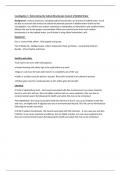Essay
applied science - unit 19 A part 3 - sodium bicarbonate - distinction level
- Course
- Institution
this is part 3 of the unit 19 A . it was graded as a distinction by my teacher Investigation 3 : Determining the Sodium Bicarbonate Content of Bottled Water
[Show more]



